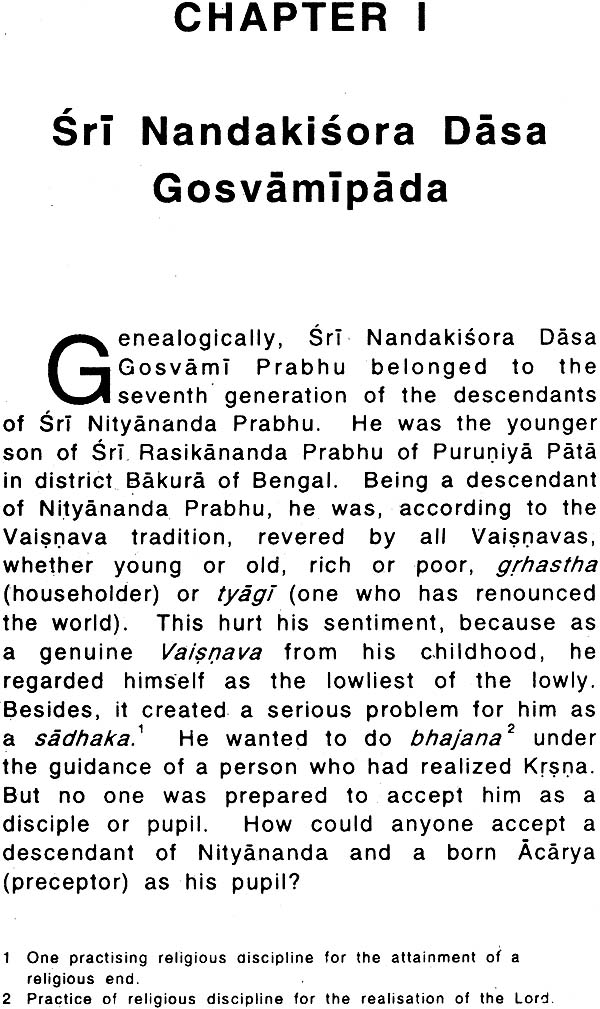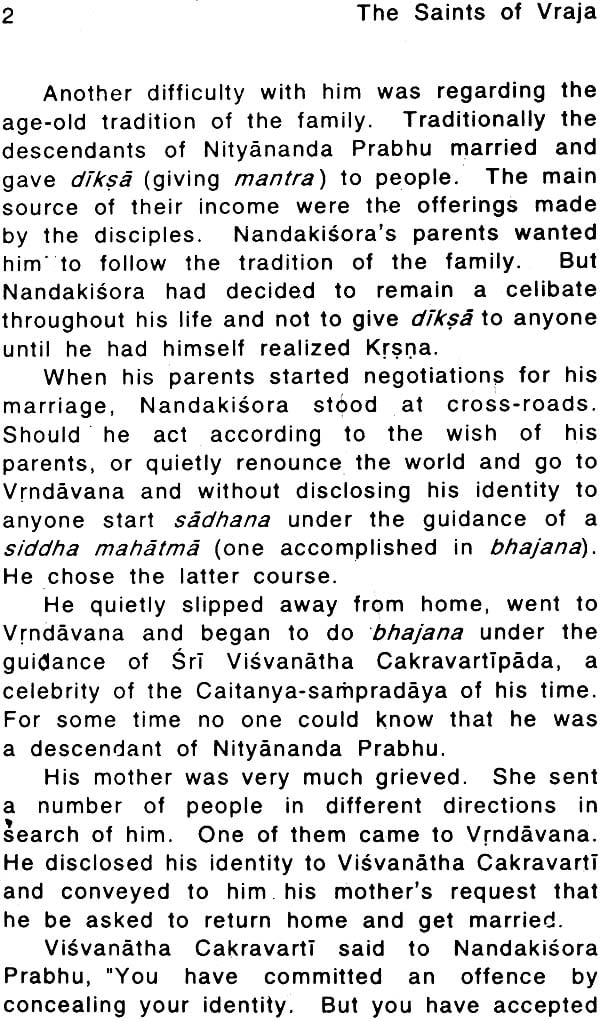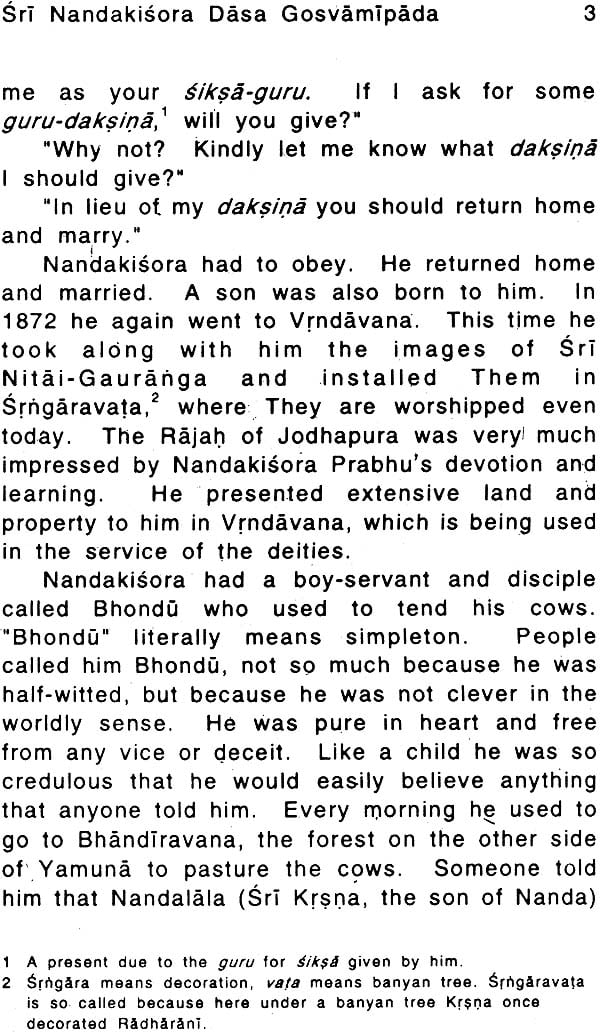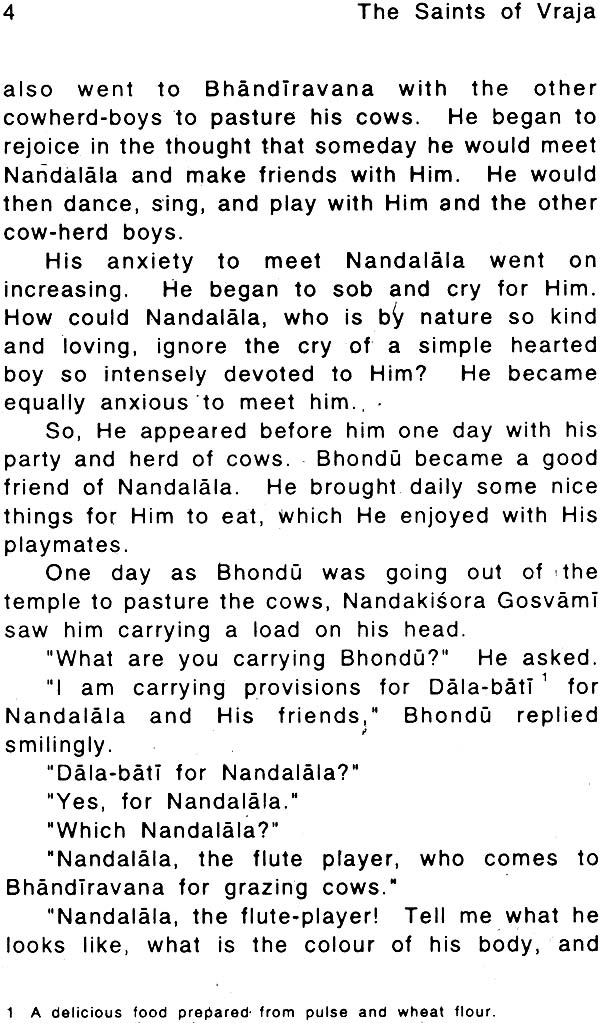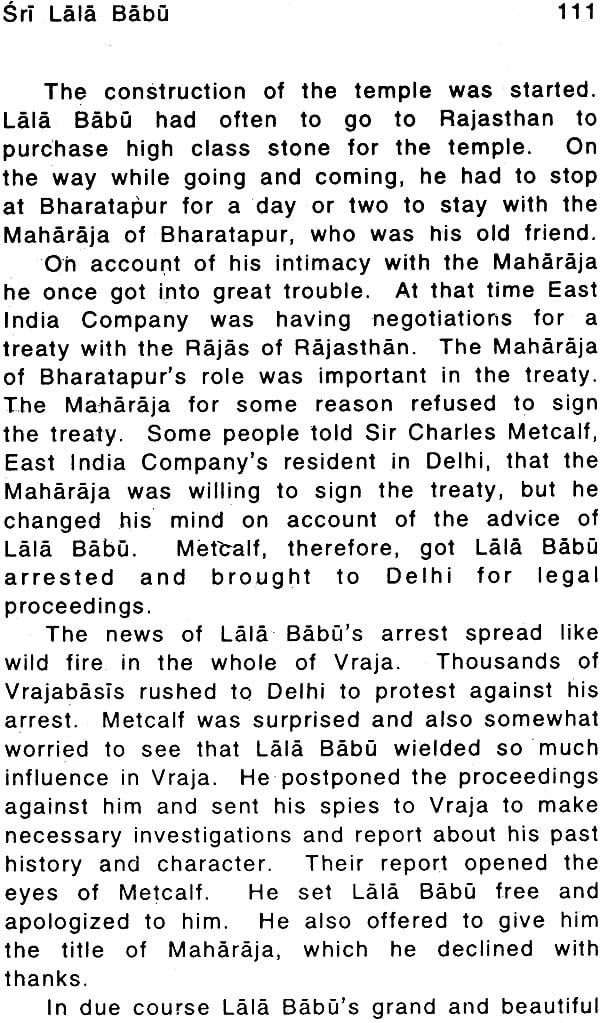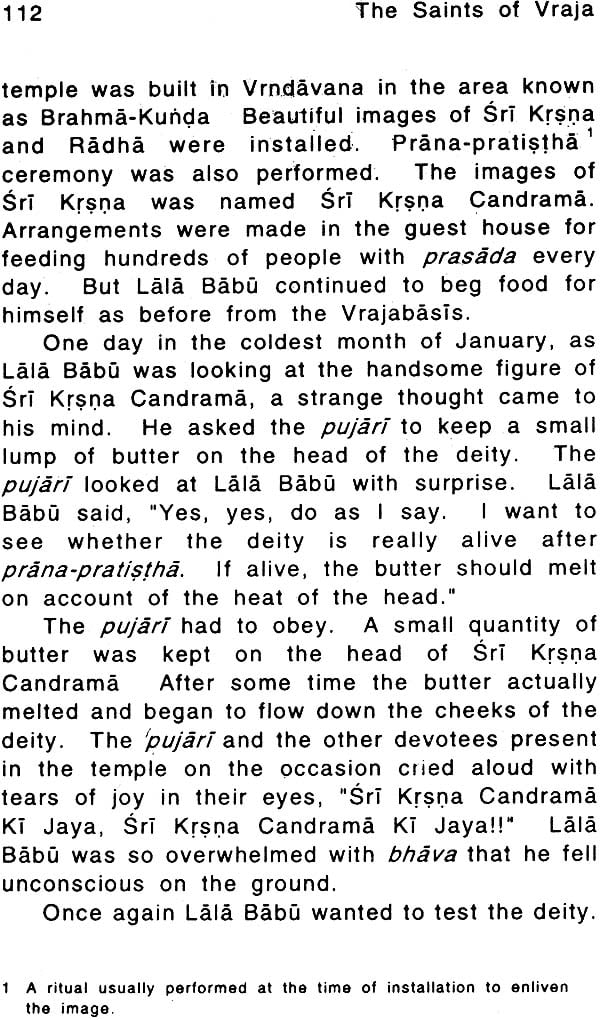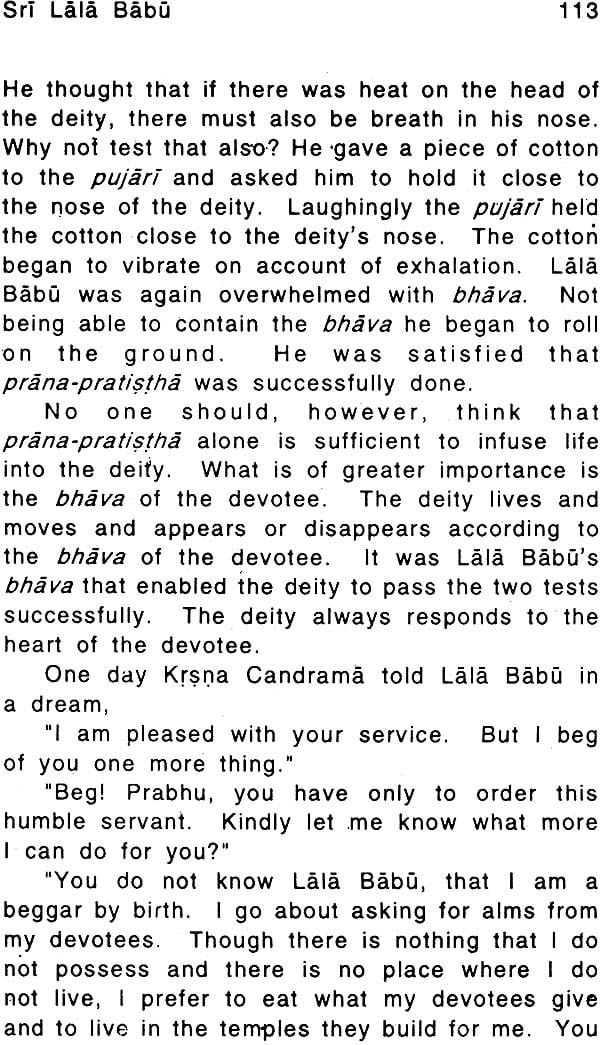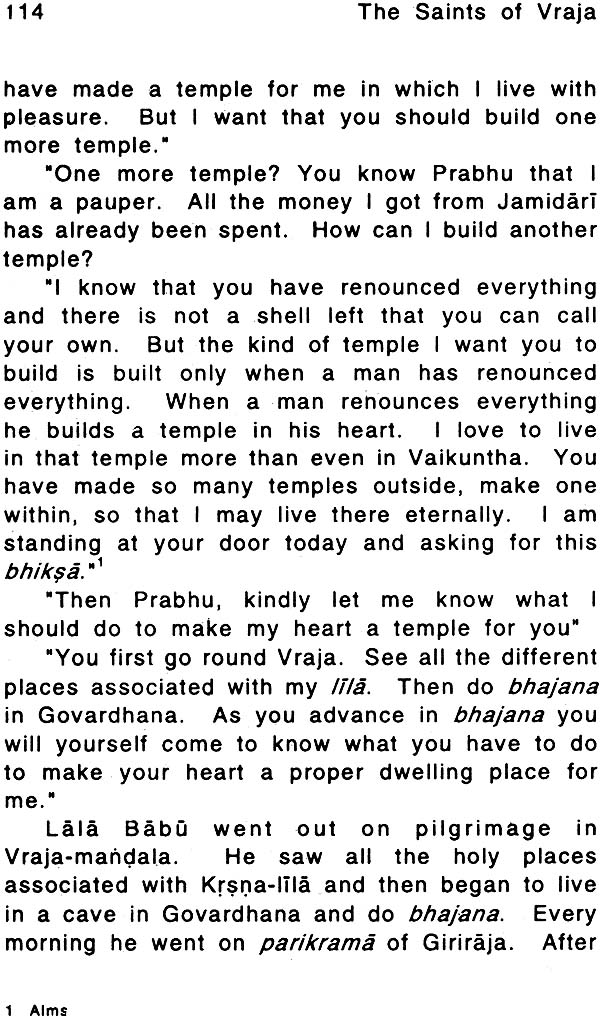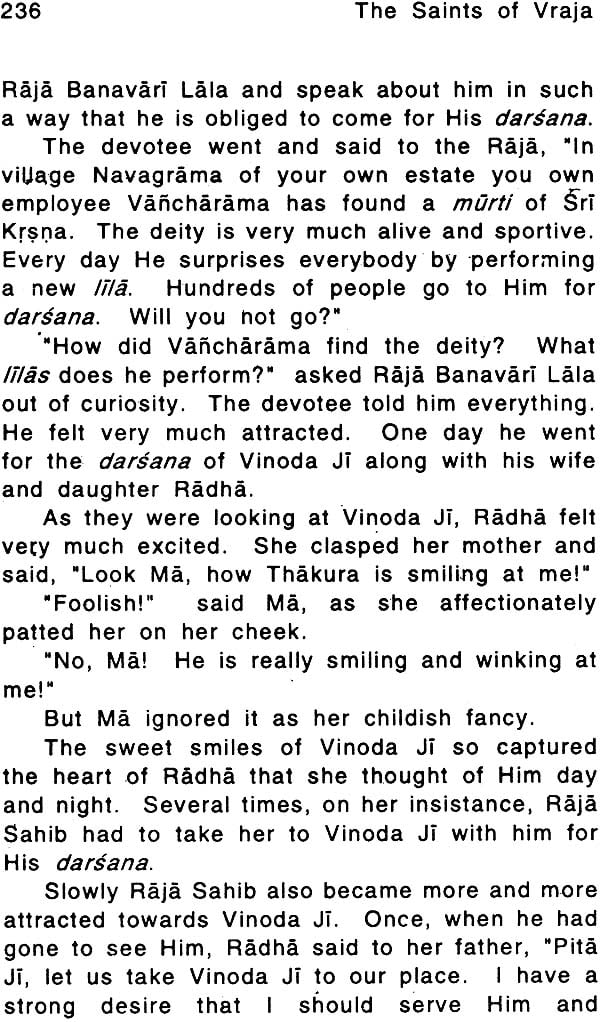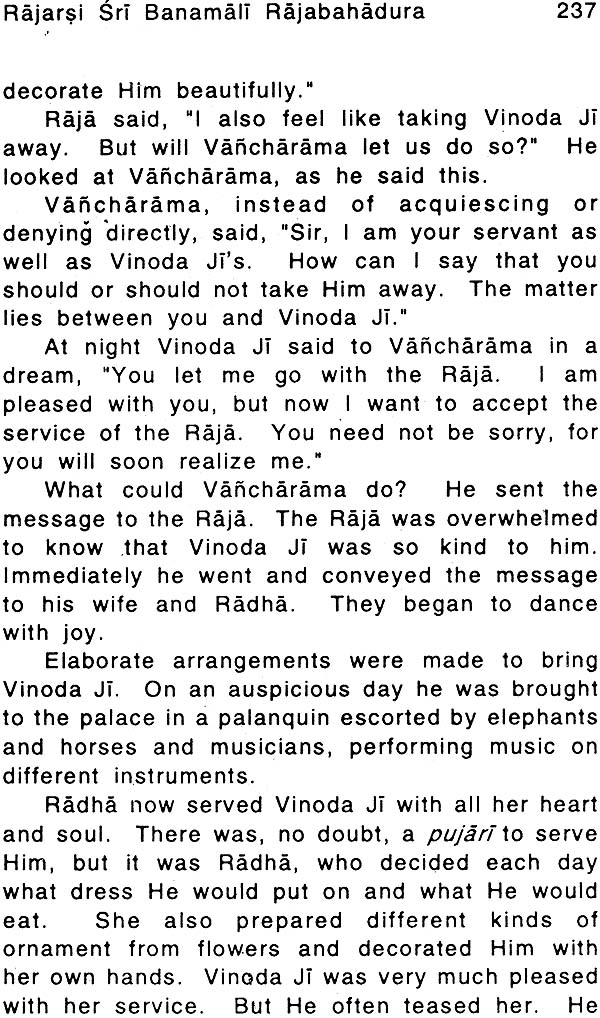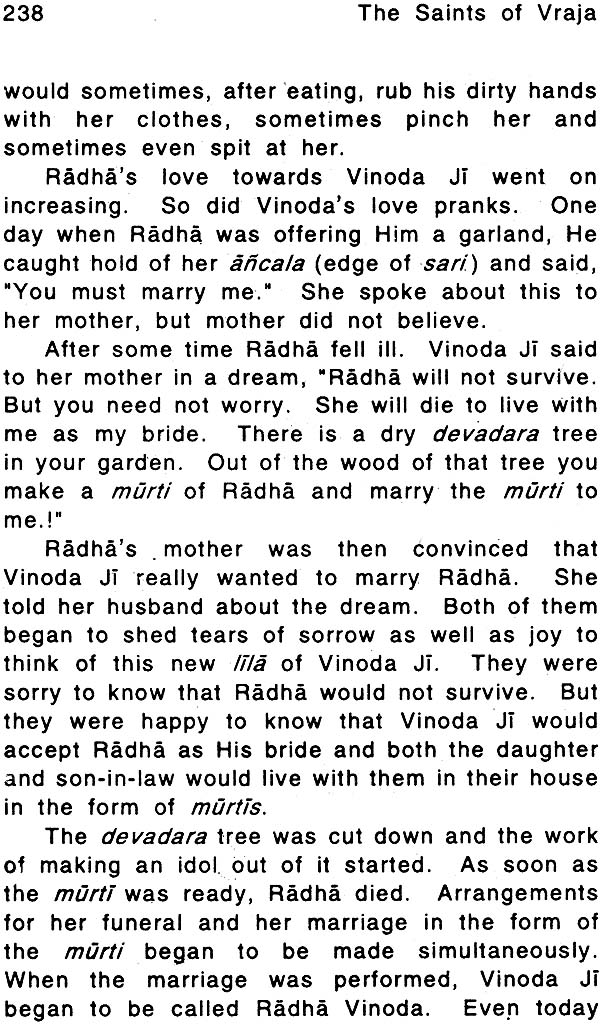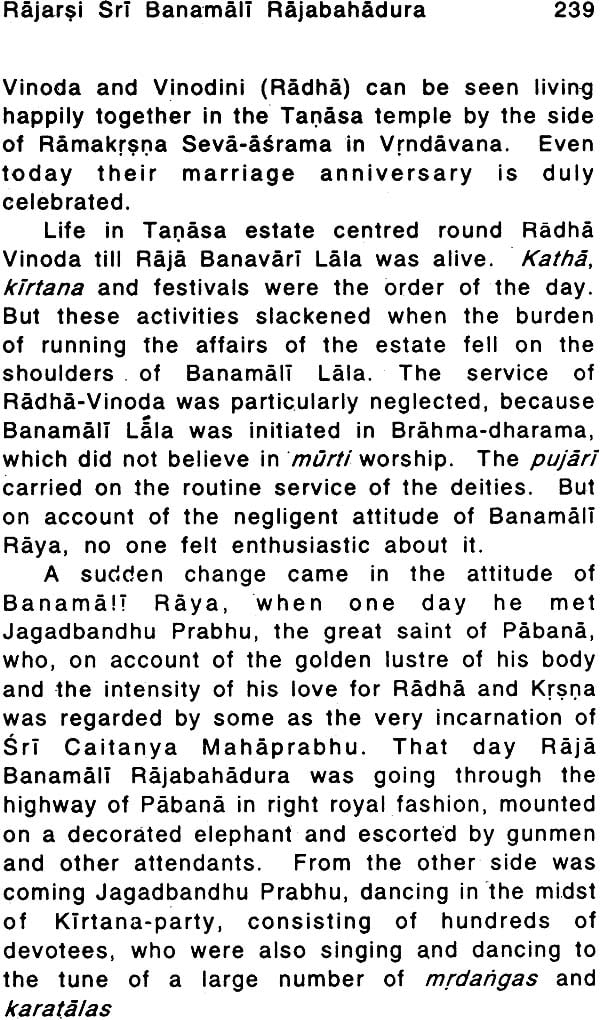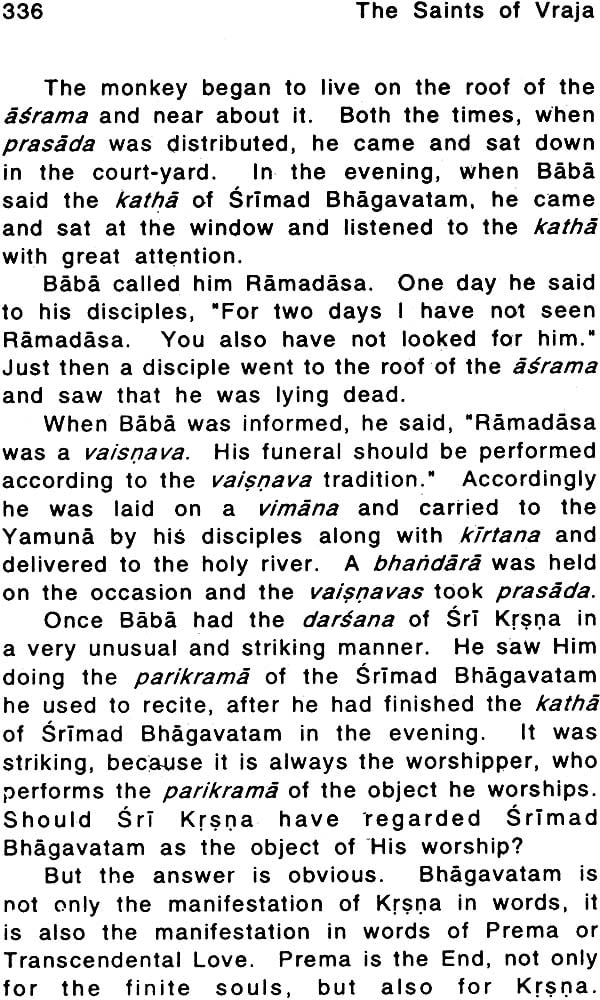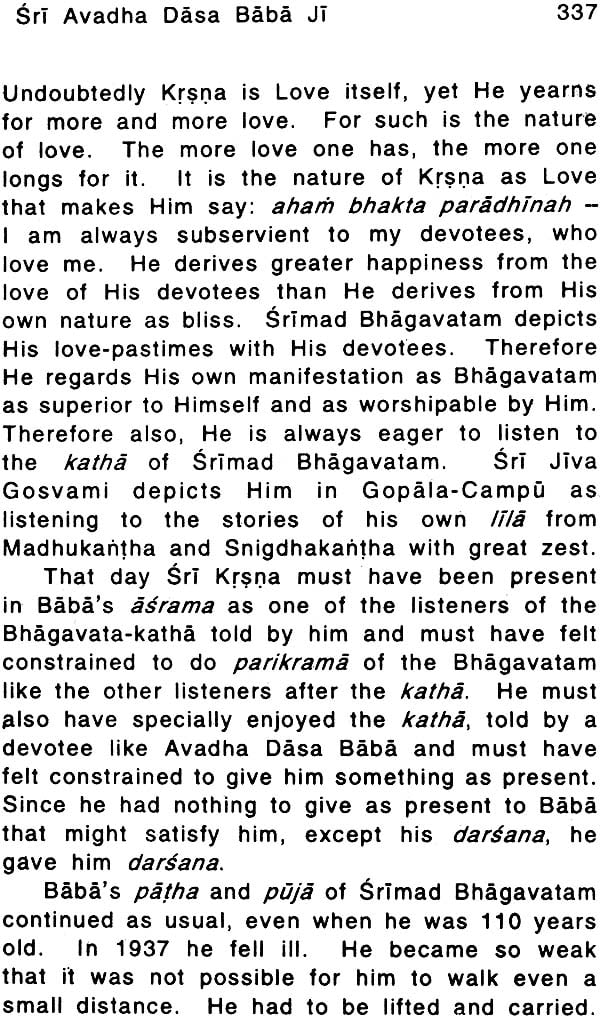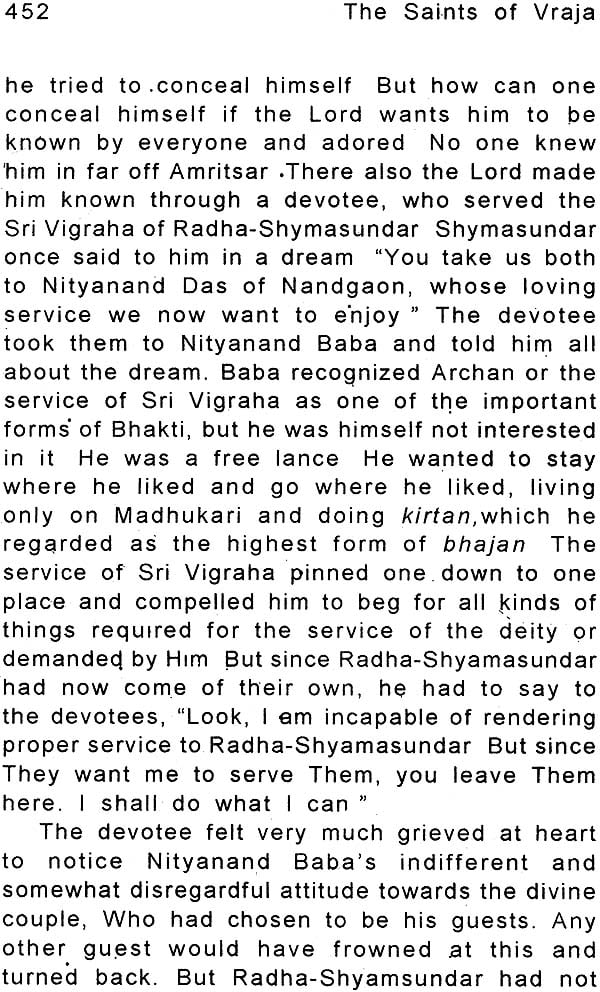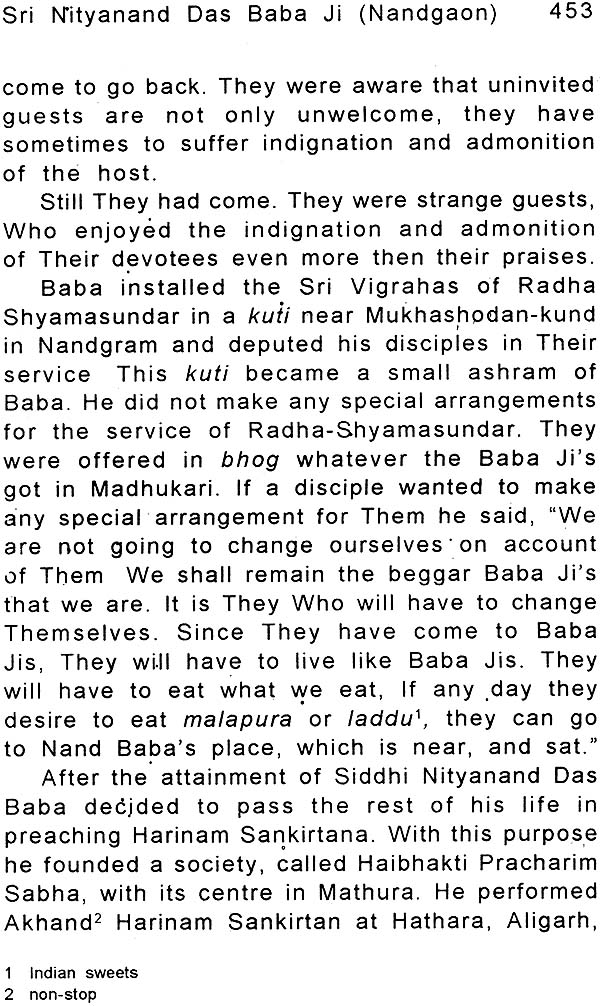
The Saints of Vraja
Book Specification
| Item Code: | IDH185 |
| Author: | O B I KAPOOR |
| Publisher: | Aravali Books International Pvt. Ltd. |
| Language: | English |
| Edition: | 2015 |
| ISBN: | 9788181501684 |
| Pages: | 485 |
| Cover: | Hardcover |
| Other Details | 8.8" X 5.8" |
| Weight | 690 gm |
Book Description
Preface
Whoever picks up this book is bound for a surprise. He is going to have a glimpse of the spiritual world, of which, perhaps, he has neither heard nor dreamt, a glimpse, which is heartening as well as thrilling and assuring beyond description. For the saints of Vraja have worshipped and realized God, not in His ordinary aspect as the Creator and Controller of the universe, as the Creator and Controller of the universe, as the mere bestower of boons or dispenser of justice, but in His highest aspect as Love and Sweetness (madhurya), in which He does not fret or frown over our faults and weaknesses but loves and adores us inspite of our failings, if only we love Him; an aspect in which He seeks us, as much as we seek Him, loves us as much as we love Him, needs us as much as we need Him, an aspect, in which He is more natural than supernatural, more human than super-human, in which he has all the failings and weaknesses of the humans, but in which paradoxical as it may seem, failings becomes His embellishments and add to His sweetness and perfection, instead of detracting from it, because they stem not from any weakness inherent in Him, but from His nature as Love and His love for those who love Him. Could He be so sweet if He did not have these weaknesses, if inspite of the fact that He is the Master of the universe, He was not greedy for the milk and butter of the milkmaids of Vraja, if to satisfy His greed He did not steal or plunder, and if He did not lie for fear of being chastised by mother Yasoda?
His sweetness (madhurya) is heightened by the fact that although He is the creator, destroyer and sustainer of the universe, He has in Vraja the conceit of the son of Nanda and Yasoda, whose name is Krsna, but who is called out of affection by various other names, like Kanhaiya, Kanhai, Kanu, Gopala and Govinda. The style of His dress, which is like that of a cowherd-boy, the peacock feather which he is fond of wearing as His crown, and His flute are all the emblems of His sweetness (madhurya) and not lordliness (aisvarya). His lordliness (aisvarya) is eclipsed by His sweetness (madhurya) to such an extent that He is not even conscious of it. This is just as it should be, for the highest development of Priti or Love is possible only when neither Krsna nor His devotees are conscious of His divinity.
The madhurya of Krsna is inseparably connected with His nature as Rasa or transcendental relish. The Taittiriya Upanisad describes Krsna as Rasa. Krsna is not only the embodiment of Rasa. As Rasa He is highest object of relish, as Rasika He is the greatest enjoyer of Rasa. His hladini sakti, the potency that causes bliss, is the ultimate source of Rasa. The hladini sakti residing in Krsna enables Him to enjoy svarupananda or the bliss that is inherent in His own self, the hladini sakti residing in the heart of His devotees, desirous of serving Krsna assumes the form of Krsna-priti or the love for Krsna which is much more relishing to Krsna than His svarupananda.
Sri Jiva Gosvami asks: how is it that Krsna's own hladini sakti provides greater happiness to Him, when it resides in the heart of His devotee? He explains this with reference to the example of the flute and the flute-player. The flute-player is capable of producing a whistling sound by blowing air out of his mouth. But when he blows the same air into the flute and makes it pass through its different holes, it produces a melodious sound, which is much more pleasing to him that the whistling sound produced by him without the aid of the flute. Similarly the hladini sakti has a relish of its own, which is sweet beyond description, when it resides in Krsna, but its sweetness enhances a thousandfold, when it is implanted in the hearts of His devotees. Therefore He always implants hladini sakti in the hearts of the devotees, who desire to serve Him.
This explains how Krsna is His madhurya aspect, in which He enters into intimate and loving relationship with His devotees more freely than in His aisvarya aspect, fully realizes His natures as Rasa. This also explains His eternal subservience to His devotees, as evident from the Bhagavata sloka, in which He says, "Even though free in all respects, I am subservient to My devotees, as if I have no freedom at all. "In the biographies of the saints of Vraja, we find numerous instances of Krsna's total dependence and willful subservience to them.
It should, however, be noted that what has been said above refers to the Krsna of Vrndavana and not to Krsna of Mathura or Dvaraka. Krsna in His highest aspect, in which His madhurya is fully displayed, is the Krsna of Vrndavana. Krsna of Mathura and Dvaraka is not the same as the Krsna of Vrndavana, but His partial manifest, called Vasudeva. It is not possible to think of Krsna of Vrndavana, but His partial manifest, called Vasudeva. It is not possible to think of Krsna with the crest of a peacock feature on His crown and a flute in His hands anywhere else. That Krsna in this form is inseparable connected with Vrndavana is testified by the fact that Radha, to whom even a moment's separation from Krsna is unbearable, is not pleased to find Him in Kuruksetra, where He appears as King with His entourage and not as cowherd with His flute.
Being a manifestation of the svarupa-sakti or the intrinsic energy of Krsna, Vrndavana is a part of Himself. It consists, like Him, of the attributes of existene, intelligence and bliss and is different from the phenomenal world, which is a manifestation of His maya-sakti of extrinsic energy. It is the proper dwelling place for Krsna, because just as Krsna is the highest manifestation of Divinity, Vrndavana is the highest Dhama (dwelling place of God). It surpasses all other Dhamas in grandeur and sweetness. But its aisvarya is completely eclipsed by its madhurya, so that everything here assumes a form that is sweet beyond expression.
The celestial Vrndavana has its replica on earth in the form of geographical Vrndavana, which is known as its prakata prakasa or manifest form.
This appears as part of the phenomenal world on account of our colored vision, but is in essence identical with its celestial counterpart. If we could see it with the spiritual eye, it would undoubtedly appear in its true form. The devotees, who attain the highest accomplishment in devotion (siddhavastha) are even today blessed with the vision of the divine Lila of Krsna with His parikaras (associates) while staying in this dhaman, in their present bodies, without being transported to any other dhama or level of existence, as the biographies of the devotees of Vraja amply testify.
Highest accomplishment in devotion can be attained through raganuga or spontaneous bhakti, which is usually practiced by the devotees of Vraja. It is different from vaidhi or ritualistic bhakti. Vaidhi Bhakti is injunctory. It consists in the observance of the rules and regulations or the rituals as lay down in the scriptures. It is conditioned by the fear of transgression of rules and is, therefore, more mechanical and formal. In raganuga bhakti there is continuous flow of raga or attachment to the Lord, which makes it impossible for the devotee to follow the rules and regulations of vaidhi bhakti. Vaidhi bhakti may be described, after Martineau, as the life of Law and raganuga bhakti as the Life of Love. Love is blind. It seeks the object of love regardless of the norms that usually guide the conduct of an ordinary devotee. It springs directly from the intrinsic potency of the name and attributes of the divine being. The devotee is automatically drawn towards the Lord, just as the senses are automatically drawn towards their objects. Devotion may be attained even without the knowledge of scriptural injunctions, though compliance with scriptural is, in most cases necessary in the earlier stages, when the mind is distracted and the natural state of composure that characterizes raganuga bhakti does not exist. External observances like the worship of Sri Murti, the partaking of Mahaprasadam and the chanting of the Holy Name are intended to gradually bring about the state of composure by diverting the mind from the object of the senses to the lotus feet of Krsna and igniting the spark of devotion that lies concealed in our heart. Once this spark is ignited, the necessity of external observances ceases. For devotion is the function of the soul, not of the body to which external observances relate. When the function of the soul is roused, the activities of the body and its senses are regulated by the spontaneous activity of the soul. The transgression of the scriptural injunctions at this stage is not voluntary, but due to the natural state of bhakti, which is an aspect of the svarupa-sakti of the Lord. If, therefore, the behaviour of the saints of Vraja sometimes appears to be abnormal it should be taken in this light.
The saints, whose biographies are included in this book, all lived during the past two and a half centuries. They are all Gaudiya Vaisnavas, that is the followers of Sri Caitanya, with the possible exception of two Hari Dasa Baba and Sanehi Rama, whose sampradaya (sect) is not known.
The saints of other sampradayas have been excluded from this work to be taken up later, if possible, in an independent work for the sake of homogeneity. It may, however, be noted that the saints of Vraja have been predominantly Gaudiya Vaisnavas, since it is Sri Caitanya Mahaprabhu and His followers, who first discovered Vrndavana in the sixteenth century, after all signs of its existence had been completely obliterated by the continued onslaughts of the Muslim aggressors for several centuries. Ever since then the Gaudiya Vaisnavas have been continually flowing into Vrndavana.
It has not been possible to arrange the biographies in strict chronological order, because in most cases the exact dates of birth and death of the saints are not known.
As regards the authenticity of these biographies it is claimed that they are by and large true, though by their very nature they preclude the possibility of being placed beyond doubt for the critical minded, who would demand supporting evidence for everything, even for the spiritual happenings and experiences for which no evidence is possible. These biographies like those of any other saints, who have realized God, contain miracles, which cannot be adjudicated upon with scientific yardsticks and galvanometers, statistics and equations. Even the scientists now admit the possible existence of a world of higher dimension, which cannot be probed into with the scientific method of piling up statistical knowledge of atoms and electrons, chromosomes and corpuscles. That world can only be probed with the sunlight of superconsciousness, not with the rush-right of science or logic. In order to know it we have to rise to a higher scale of existence. We can know it then through what we become and not through what we observe, think or deduce with our mind, such as it is.
The sources from which the material for these biographies has been drawn are fairly reliable. One of the most important sources is the scattered record found in the form of sucaka-kirtans. Sucaka-kirtans are summary accounts of the life of saints recorded by their followers in Bengali verses to be sung according to the Gaudiya Vaisnava tradition at the time of celebration of their death-anniversary, every year. Some books giving long or short biographies of these saints are also available in Bengali. The most important of these is the Gaudiya Vaisnava Jivana, written by Sri Hari Dasa Dasa himself, a siddha saint and scholar of repute, which was published in 1951. These, along with such material as could be obtained from interviews with knowledgeable sources mainly constituted the date for these biographies.
The biographies of some of the saints are too short and sketchy and need to be further explored. I have, on my part, recorded whatever material was available so that it was not lost.
I would not further extend this preface except for the brief but pleasant task of acknowledgment, though, for each one of those, who was of any service in the publication of this book, the service has been a labor of love and acknowledgment is but an awkward formality, I would be failing in my duty if I do not express my thanks for the service rendered by them. My sincere thanks go out to Srimati Vedashastri for kindly typing the manuscript and reading the proofs and to Sri Mulkaraja Virmani, who has also kindly assisted in reading the proof.
Back of the Book
The saints of Vraja, whose biographies are here described, realized God, not in His ordinary aspect as the Creator and Controller of the universe, but in His highest aspect as love and sweetness (Madhurya), in which He does not fret or frown over our faults and weaknesses, but loves and adores us, inspite of our failings, if only we love Him; in which He seeks us as much as we seek Him, needs us a much as we need Him.
In this aspect he can be realized through Raganuga Bhakti; or the current of devotion that flows spontaneously and ceaselessly from our heart over running in its course all barriers of scriptural forms and injunctions.
The saints of Vraja are illustrious examples of this kind of bhakti. Their life-stories in-still faith in the heart of the reader and automatically set him on the path of realization of God in His sweetest aspect, in which he love and wants to be loved and to revel always in pastimes of love, with those, who love Him.
About the Author
Born in 1909, Dr. O.B.L. Kapoor took his M.A. degree in Philosophy from the University of Allahabad in 1931 and the degree of Doctor of Philosophy from the same university in 1938. he worked as Research Fellow, Indian Institute of Philosophy. Amainer, D.Lite Scholar University of Allahabad and Professor and Head of the Dept. of Philosophy, B.R. College, Agra till 1952, after which he joined U.P. Educational Service Class I and worked as Professor and Head of the Dept. of Philosophy, K.N. Govt. College, Gyanpur (Varanasi) and Principal, Govt. College Gyanpur/Rampur till his retirement in 1967. Since 1967 he has been living in Vrndavana and writing books and articles on religious topics related mainly to Bhakti. He has so far written more than 25 books and a large number of articles, published in different journals. His writings have provided inspiration to the academicians and non-academicians alike and have set many firmly on the path of Bhakti.
| PREFACE | XI |
| CHAPTER I | |
| Sri Nandakisora Dasa Gosvamipada | 1 |
| CHAPTER II | |
| Sri Haridasa Baba Ji | 9 |
| CHAPTER III | |
| Sri Jaikrsna Dasa Baba Ji | 15 |
| CHAPTER IV | |
| Sri Krsna Dasa Baba Ji | 23 |
| CHAPTER V | |
| Sri Srikrsnadasa Baba Ji | 41 |
| CHAPTER VI | |
| Sri Nityananda Dasa Baba Ji | 47 |
| CHAPTER VII | |
| Sri Madhusudana Dasa Baba Ji | 51 |
| CHAPTER VIII | |
| Sripada Navakisora Gosvami & Sripada Locanananda Gosvami | 61 |
| CHAPTER IX | |
| Sri Jagannatha Dasa Baba Ji | 71 |
| CHAPTER X | |
| Sri Gaurakisora Siromani | 87 |
| CHAPTER XI | |
| Sri Gauracarana Dasa Baba Ji | 97 |
| CHAPTER XII | |
| Sri Lala Babu | 105 |
| CHAPTER XIII | |
| Sri Sanehirama Ji | 123 |
| CHAPTER XIV | |
| Pisi Ma Gosvamini & Sri Gopesvara Gosvami | 127 |
| CHAPTER XVI | |
| Sri Radharamana Ghosa Bhagavata-Bhusana | 145 |
| CHAPTER XVII | |
| Sri Jagadisa Dasa Baba Ji | 153 |
| CHAPTER XVIII | |
| Pandita Sri Ramakrsna Dasa Baba Ji | 165 |
| CHAPTER XIX | |
| Sri Manohara Dasa Baba Ji | 191 |
| CHAPTER XX | |
| Sri Madhava Dasa Baba Ji | 195 |
| CHAPTER XXI | |
| Sri Jagnnatha Dasa Baba Ji (Barasana) | 205 |
| CHAPTER XXII | |
| Sri Pranakrsna Dasa Baba Ji | 211 |
| CHAPTER XXIII | |
| Sri Manasinha Rajavata | 219 |
| CHAPTER XXIV | |
| Rajarsi Sri Banamali Rajabahadura | 231 |
| CHAPTER XXV | |
| Sri Krsna Caitanya Dasa Baba | 245 |
| CHAPTER XXVI | |
| The Blind Baba Ji of Madanatera | 261 |
| CHAPTER XXVII | |
| Sri Gauranga Dasa Baba Ji | 267 |
| CHAPTER XXVIII | |
| Sri Krsnaprema (Ronald Nixon) | 293 |
| CHAPTER XXIX | |
| Sri Gauragovinda Dasa Baba Ji | 313 |
| CHAPTER XXX | |
| Sri Sacinandana Dasa Baba | 323 |
| CHAPTER XXXI | |
| Sri Avadha Dasa Baba Ji | 331 |
| CHAPTER XXXII | |
| Sri Gopala Dasa Baba Ji | 339 |
| CHAPTER XXXIII | |
| Sri Harigopala Gosvami | 343 |
| CHAPTER XXXIV | |
| Sri Ramakrsna Dasa Baba Ji | 347 |
| CHAPTER XXXV | |
| Sri Radharamana Dasa Baba Ji | 357 |
| CHAPTER XXXVI | |
| Shah Kundan Lal and Shah Phundan Lal | 365 |
| CHAPTER XXXVII | |
| Gulab Sakhi | 377 |
| CHAPTER XXXVIII | |
| Chota Baba | 383 |
| CHAPTER XXXIX | |
| Karta Krsnadas Baba | 389 |
| CHAPTER XL | |
| Sri Navalakishor Baba | 395 |
| CHAPTER XLI | |
| Pandit Jagadanand Das Baba Ji | 405 |
| CHAPTER XLII | |
| Sri Gulab Das Baba | 407 |
| CHAPTER XLIII | |
| Gvariya Baba | 411 |
| CHAPTER XLIV | |
| Durlabh Das Baba Ji | 427 |
| CHAPTER XLV | |
| Anant Das Baba JI | 429 |
| CHAPTER XLVI | |
| Smt. Girija Devi | 433 |
| CHAPTER XLVII | |
| Sri Gauranga Das Baba Ji (Madan Thaur) | 443 |
| CHAPTER XLVIII | |
| Sri Nityanand Das Baba Ji (Nandgaon) | 447 |
| CHAPTER XLIX | |
| Raghunath Das Gosvami | 461 |
